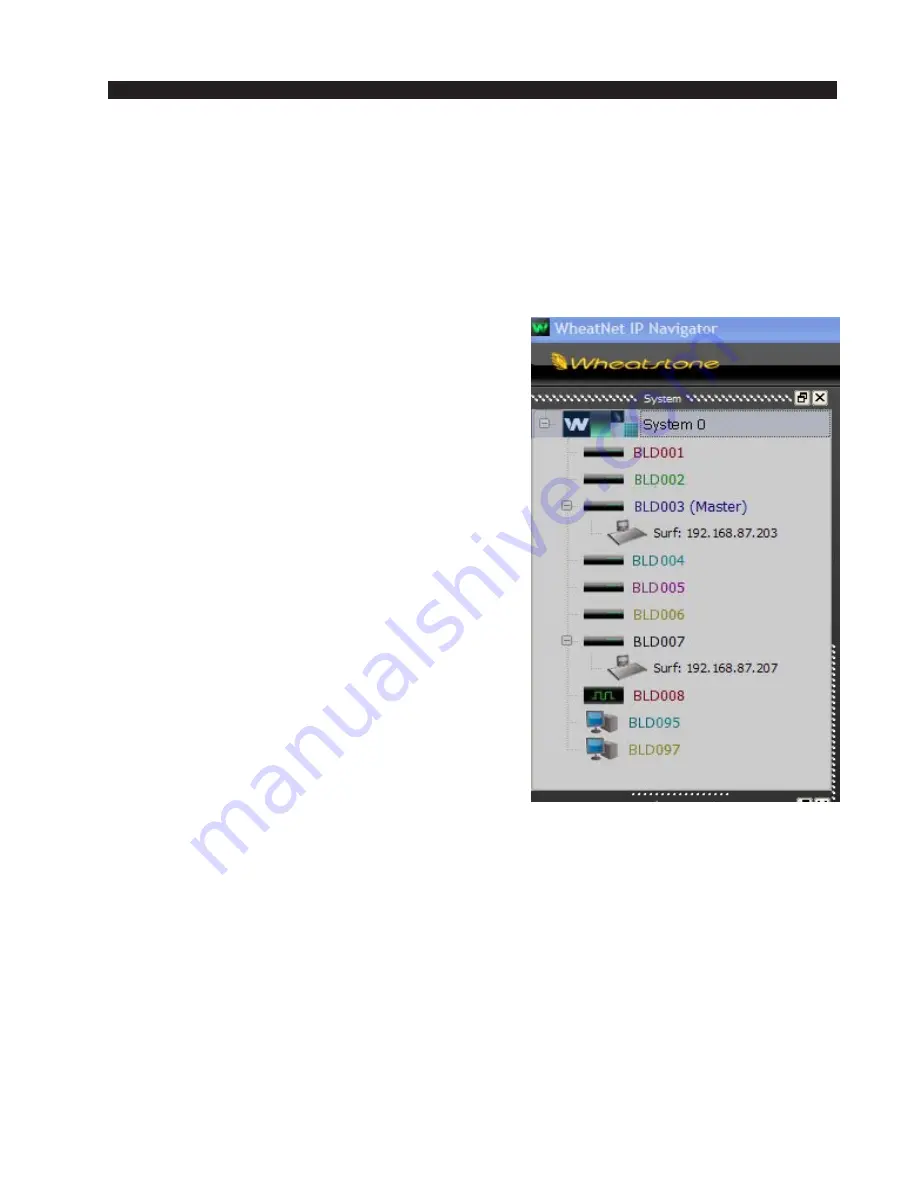
W H E A T N E T - I P S Y S T E M O P E R A T I O N A L M O D E S
page 2 – 14
WheatNet-IP
/ Apr 2009
WheatNet-IP Networks and What They Do
Let’s look at a WheatNet-IP network in more detail. What exactly is an
“WheatNet-IP network?” Simply put, it is a collection of WheatNet-IP devices and
driver equipped PCs connected together via an Ethernet LAN. In a WheatNet-IP
network, each device is represented as a “BLADE” with a unique BLADE ID.
Each WheatNet-IP rackmount unit is a BLADE, each control surface rackmount
engine is a BLADE, and even each driver equipped PC is a BLADE. The Navigator
GUI gives a Windows Explorer style device tree
system view showing all of the devices currently
connected in the system.
You’ll notice in the example at the right that there
are eight WheatNet-IP rackmount units connected in
this system, with IDs 1 - 8. You’ll notice 3 and 7
control surface engines, with the control surface at
IPs 192.168.87.203 and 192.168.87.207 associated
with them. Finally, you’ll notice PCs with IDs 95 and
96 connected as well; these are typically your Auto-
mation PCs, but in the WheatNet-IP system each is
represented as a PC style BLADE.
This system tree view given by the Navigator GUI
is a very handy tool for monitoring your system. It
sure beats scrolling through a long list of names from
the front panel of a BLADE. It will always show your
system connection status. This is a very important
point and indicates a big feature of the WheatNet-IP
system. Every WheatNet-IP network system is dy-
namic. Devices can be added to it or removed from it
at will, in real time, just like computers in your LAN.
As you add a WheatNet-IP device to the network (by
plugging it in and assigning it a BLADE ID) it’s
associated signals are also automatically added and
made available to the system. They will show up in
the front panel displays of other BLADEs, and insert
themselves into the crosspoint grid of the Navigator
GUI. No complicated configuration or IP management is required; the BLADEs
take care of it all for you.
Should you need to remove a device (say because you want to borrow it to use
elsewhere), no problem. Just unplug it from the network and it and its signals will
automatically “disappear.” Later on, if you want to add it back in, again no
problem. Just plug it back in and use the same BLADE ID it previously had when
it was in the system. It will reappear in the network with all of its old signal names,
logic connections, silence detect settings, etc. The distributed intelligence of the
WheatNet-IP system “knew” it was missing and reserved all of the information for
when it came back. You don’t have to reconfigure anything.
So what does this WheatNet-IP network actually do? Actually, quite a lot of
things. First and foremost, it transports audio from one device to another, or others.
It matters not whether the devices are analog or digital, rackmount BLADEs or
PCs or control surfaces. Once an audio signal is present in the system, it can be
WheatNet-IP
/ June 2010
Содержание WheatNet-IP Blade3s
Страница 2: ...TECHNICAL MANUAL Wheatstone Corporation April 2009 AUDIO OVER IP NETWORK WheatNet IP ...
Страница 13: ...Quick Start 7 WheatNet IP Apr 2009 Figure 4 ...
Страница 224: ...A P P E N D I C E S page A 34 WheatNet IP Apr 2009 Appendix 5 Contents External Controllers A 35 ...
Страница 238: ...page A 48 WheatNet IP Mar 2014 A P P E N D I C E S Click Next Click Install ...
















































